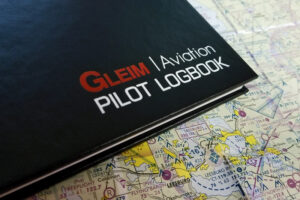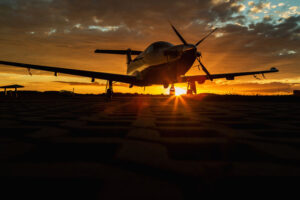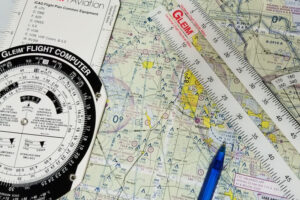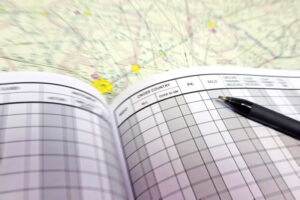 One of the most basic tasks a pilot does is record flight time in a logbook. However, once you pass your check ride and are no longer logging “dual received” every flight, things can start to get a little complicated. When do you log time as PIC? What is the difference between acting as PIC and logging PIC time? What about SIC time or time as a safety pilot? When should you log cross-country time? What about solo time? In this week’s blog, we will answer all of these questions and more.
One of the most basic tasks a pilot does is record flight time in a logbook. However, once you pass your check ride and are no longer logging “dual received” every flight, things can start to get a little complicated. When do you log time as PIC? What is the difference between acting as PIC and logging PIC time? What about SIC time or time as a safety pilot? When should you log cross-country time? What about solo time? In this week’s blog, we will answer all of these questions and more.
Logging pilot-in-command (PIC) time is one of the most confusing types of flight time to log. In order to log this time correctly, you have to understand the difference between acting as PIC and logging PIC time.
According to 14 CFR § 1.1:
Pilot in command means the person who:
(1) Has final authority and responsibility for the operation and safety of the flight,
(2) Has been designated as pilot in command before or during the flight, and
(3) Holds the appropriate category, class, and type rating, if appropriate, for the conduct of the flight.
In order to act as PIC, you must be designated as PIC for the flight and you must actually be qualified to act as PIC for the aircraft (meaning you must hold the appropriate certificates, ratings, and applicable endorsements). In addition, there are several other regulations that expand the requirements to act as PIC:
- 14 CFR § 61.3(a) and (c) further clarify that the PIC must possess a pilot certificate, photo ID, and a medical certificate.
- § 61.3(e) adds that a person acting as PIC under IFR must hold an instrument rating.
- § 61.31 requires the PIC hold the appropriate ratings and endorsements for the aircraft type being flown.
- § 61.56 requires the pilot to have a current flight review.
As long as you meet all of the above requirements, you may legally act as PIC. However, just because you are acting as PIC, does not mean you are able to log PIC time, and you may be able to log PIC time when you are not acting as PIC. Confused yet? The FAA lists separate requirements to log PIC time in § 61.51(e)(1). Let’s take a look.
(e) Logging pilot-in-command flight time.
(1) A sport, recreational, private, commercial, or airline transport pilot may log pilot in command flight time for flights-
(i) When the pilot is the sole manipulator of the controls of an aircraft for which the pilot is rated, or has sport pilot privileges for that category and class of aircraft, if the aircraft class rating is appropriate;
(ii) When the pilot is the sole occupant in the aircraft;
(iii) When the pilot, except for a holder of a sport or recreational pilot certificate, acts as pilot in command of an aircraft for which more than one pilot is required under the type certification of the aircraft or the regulations under which the flight is conducted.
This section lists three circumstances that allow you to log PIC time. The most straightforward case is when you are flying solo. You are the only person in the aircraft, so if you are not the pilot in command, who is? This is true even if you are a student pilot during a solo training flight. As a student pilot, your instructor’s endorsements qualify you to fly solo; therefore, you are allowed to act as PIC and log solo flight time as PIC.
What happens if, after you pass your check ride, you decide to take a friend flying with you? As long as you are rated in the aircraft and are the sole manipulator of the controls, you are able to log PIC time. But if your friend is also a pilot and wants to take turns flying, you are only able to log PIC time when you are the pilot flying, even though you may be acting as PIC for the duration of the flight. While your friend is flying, you may not log any flight time.
Unless the aircraft requires more than one pilot. You most likely won’t run into an aircraft with a type certificate requiring more than one pilot while flying small general aviation planes. However, there is additional wording in this rule that often does apply to general aviation pilots. If two pilots are required by “the regulations under which the flight is conducted,” then you may both log PIC time if you are acting as PIC and your friend is flying. So, when would this apply?
The most common situation this applies to is when acting as a safety pilot. According to 14 CFR § 91.109(c)(1), a safety pilot is required to operate in simulated instrument conditions, that means the safety pilot is a required pilot flight crewmember. Therefore, if designated as PIC for the flight and appropriately rated, the safety pilot may log PIC time while the pilot flying is under the hood. In addition, the pilot flying may also log PIC time as the sole manipulator of the controls. If the safety pilot is not designated as PIC, then second-in-command (SIC) time may be logged because the safety pilot is still a required crewmember.
What about logging solo time? Solo refers to time when the pilot is the sole occupant in the aircraft. Whenever you have a live passenger on board, you are not the sole occupant of the airplane. We’ll save “souls on board” for another topic! Therefore, even if you are taking your 2-year-old for his first airplane ride, you cannot log solo time.
 Logging night time is another area that can be confusing. In order to properly understand how to log night time, there are three definitions of night you need to be familiar with. The first, according to 14 CFR § 91.209, requires you to have your position lights on from sunset to sunrise, but this is not necessarily the period you will be logging night time.
Logging night time is another area that can be confusing. In order to properly understand how to log night time, there are three definitions of night you need to be familiar with. The first, according to 14 CFR § 91.209, requires you to have your position lights on from sunset to sunrise, but this is not necessarily the period you will be logging night time.
According to 14 CFR 1.1, “Night means the time between the end of evening civil twilight and the beginning of morning civil twilight, as published in the Air Almanac, converted to local time.” This is the period in which you may log night time. Civil twilight ends roughly half an hour after sunset; technically, civil twilight is when the geometric center of the sun is 6° below the horizon. (Yes, there is an Android and iPhone app for that.) So, if you take off at sunset, the first portion of your flight cannot be logged as night time until after civil twilight.
But even after civil twilight there are still restrictions on what can be considered “night.” For the purposes of currency, you must use the period of 1 hour after sunset to 1 hour before sunrise. This is found in 14 CFR § 61.57(b). It is during this time when you may log night landings to gain currency for carrying passengers at night.
Another type of flight time that is often logged incorrectly (or not at all) is cross-country time. In order to log cross-country time correctly, you have to understand the definition of cross-country time. This definition varies depending on the purpose of how you intend to use the logged time and further varies depending on the type of certificate you might need to use that time for.
 14 CFR § 61.1(b)(3)(i) defines cross-country as any flight that includes landing at a point other than the point of departure and the use of dead reckoning, pilotage, electronic navigation aids, radio aids, or other navigation systems to navigate to the landing point. Therefore, if you take off at one airport and land somewhere else, even if it is only 3 miles away, it is by definition a cross-country flight and able to be logged as such.
14 CFR § 61.1(b)(3)(i) defines cross-country as any flight that includes landing at a point other than the point of departure and the use of dead reckoning, pilotage, electronic navigation aids, radio aids, or other navigation systems to navigate to the landing point. Therefore, if you take off at one airport and land somewhere else, even if it is only 3 miles away, it is by definition a cross-country flight and able to be logged as such.
However, for the purposes of meeting most of the cross-country requirements for private, instrument, or commercial pilot training, 14 CFR § 61.1 (b)(3)(ii) defines cross-country flights as a straight-line flight distance of at least 50 NM from the original point of departure to the destination. Even if there are smaller legs in between, it still counts if the total distance (one way) is at least 50 NM from the departure point.
For sport pilots, the cross-country requirement is only 25 NM (straight line). But, if they want to later get their private, any cross-country flights under 50 NM don’t count.
For ATP, a cross-country flight is any flight more than 50 NM (straight-line distance) from the original departure point, BUT there is no requirement to land somewhere else. So you could, hypothetically, take off, fly 50+ miles away (straight line), turn around, and land where you started. That counts towards ATP, but not towards other certificates.
 The Gleim Pilot Logbook makes it easy to track all of your flight time. Along with all of the typical fields, such as aircraft type, instrument, night, PIC, etc., there is an additional column under the heading of Cross Country. This allows you to track “All” cross-country time and time spent on cross-country flights “Over 50 NM.” You’ll find that the columns in our logbook will make it far easier for you to track your time, fill out your 8710 airman certificate and/or rating applications, and enter different types of time in IACRA.
The Gleim Pilot Logbook makes it easy to track all of your flight time. Along with all of the typical fields, such as aircraft type, instrument, night, PIC, etc., there is an additional column under the heading of Cross Country. This allows you to track “All” cross-country time and time spent on cross-country flights “Over 50 NM.” You’ll find that the columns in our logbook will make it far easier for you to track your time, fill out your 8710 airman certificate and/or rating applications, and enter different types of time in IACRA.
Logging flight time may be a basic task, but it is important to keep an accurate record of all of your hard-earned hours. From a legal standpoint, make sure you are not logging time that you should not be. Many pilots sell themselves short by not logging their time correctly. Whatever type of flying you do, be sure that you know the regulations and take full advantage of all the time you can log.
Written by Karl Winters, Gleim Aviation Editor and Flight Instructor
About Gleim Aviation
Since 1980, Gleim Aviation’s team of pilots, instructors, writers, designers, and programmers has helped aviators pass millions of FAA knowledge and practical tests using the unique Gleim Knowledge Transfer System. Gleim is an environmentally-friendly company headquartered in Gainesville, FL.

